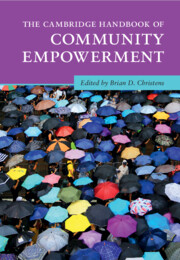Book contents
- The Cambridge Handbook of Community Empowerment
- Cambridge Handbooks in Psychology
- The Cambridge Handbook of Community Empowerment
- Copyright page
- Contents
- Figures
- Tables
- Contributors
- Building Community Power
- Part I Organizing and Activism
- Part II Participatory Governance
- 7 Citizens’ Governance Spaces
- 8 Participatory Budgeting
- 9 Participatory Urban Planning
- 10 Youth Policy Advocacy in Municipal Governance
- Part III Civil Society and Coalitions
- Part IV Enterprise
- Part V Participatory and Community Arts
- Part VI Education and Engaged Research
- Contributor Details
- Index
- References
8 - Participatory Budgeting
from Part II - Participatory Governance
Published online by Cambridge University Press: 18 April 2024
- The Cambridge Handbook of Community Empowerment
- Cambridge Handbooks in Psychology
- The Cambridge Handbook of Community Empowerment
- Copyright page
- Contents
- Figures
- Tables
- Contributors
- Building Community Power
- Part I Organizing and Activism
- Part II Participatory Governance
- 7 Citizens’ Governance Spaces
- 8 Participatory Budgeting
- 9 Participatory Urban Planning
- 10 Youth Policy Advocacy in Municipal Governance
- Part III Civil Society and Coalitions
- Part IV Enterprise
- Part V Participatory and Community Arts
- Part VI Education and Engaged Research
- Contributor Details
- Index
- References
Summary
Participatory budgeting (PB) is a democratic process that engages citizens in public investment decisions through a mix of deliberation, representation, and voting. This chapter describes how this democratic innovation has been practiced, elaborates its goals, provides an overview of its origins and diffusion, and reviews research on its outcomes for citizen engagement, local governance, and community empowerment. These findings are illustrated by two case studies. Porto Alegre, Brazil, not only represents the birthplace of PB, but also is an example of uniquely pronounced changes in government responsiveness to underserved communities and in the strength of civil society organizations after PB’s implementation. New York City’s program is fairly representative of PB as practiced in the Global North. Controlling a smaller share of city budgets, processes like PBNYC have been more able to replicate Porto Alegre’s model of equitable citizen engagement than to transform urban governance or the organization of local civil society.
Keywords
- Type
- Chapter
- Information
- The Cambridge Handbook of Community Empowerment , pp. 216 - 240Publisher: Cambridge University PressPrint publication year: 2024

